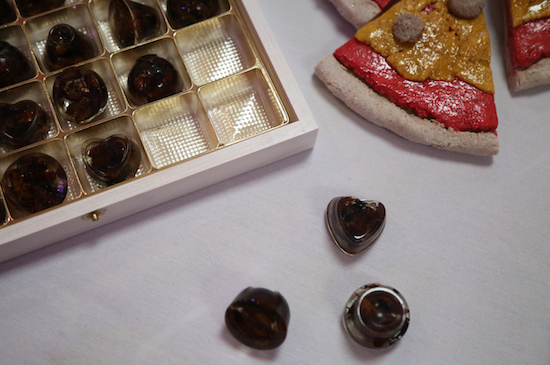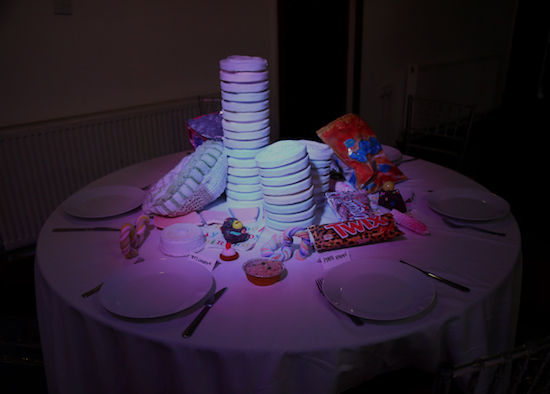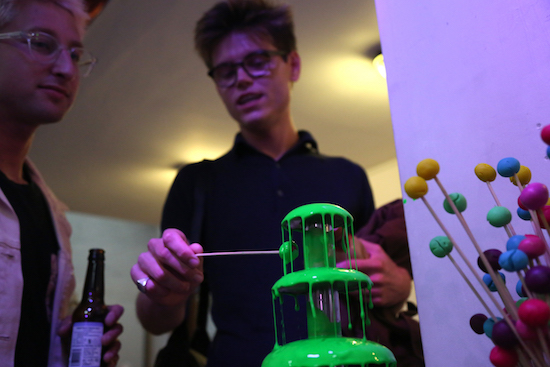“A guy actually ate that on the opening night.”
Anna Choutova is pointing to ‘The Holy Fountain’, her own contribution to the show she curated entitled Let Them Eat Fake. It’s a chocolate fondue fountain spilling forth an endless stream of lime green acrylic paint. By its side, a pile of skewers bearing playdoh marshmallows sit ready and waiting to be dunked. It is, quite possibly, the least appealing food stuff I have ever seen.
“It’s supposed to look as poisonous as possible,” Choutova confirms.
“…”
“And he ate it.”
“…”
“I hope he’s alright.”
The idea behind Let Them Eat Fake came to Choutova towards the end of last year as she passed a Japanese restaurant in Soho. “You know you get the fake sushi and ramen? I saw that and I was just standing there for a while,” she recalls. “And it just really stuck in my mind. I was like, why is that so powerful to me? Why does that look just so good?”
She put out an open call through a few different art websites seeking contributors to “a banquet of inedible food.” The work, it said, “should represent food” but it “should strictly NOT be edible.” The response was overwhelming. “I thought this is so niche, it’s going to be like my fucking chocolate fountain and an empty room. But loads of people responded – I got more of a response to that than any I’ve put on before – and loads of international artists.”
The final show includes works from some thirty different artists, from the UK, USA, the Netherlands, Germany, and Georgia. It is an absolute smorgasbord of horror. There are boxed praline chocolates that prove, on closer inspection, to be cockroaches cast in resin. Grey sandwiches and lollipops made of coal ash, and resin, like remains from some nuclear holocaust. Red and white nail varnish re-labelled with Heinz ketchup and mayonnaise stickers.
The total show looks less like your standard white cube exhibition, more like some kind of nightmare wedding. On the opening night, there were flashing stage lights and a DJ playing disco music.

Zoran Georgiev – artists own photo
“I’ve always been obsessed with food and art,” Chotova tells me. “Like Paul McCarthy, the way he uses food as a really grotesque and alien thing. I started drawing parallels between the kind of work that he does and the M&S ads with the melting cakes. It’s so on the same page. This sort of hyper-sexualised depiction of food. The way food is being shown in society and in media and advertising depicts it as being everything other than what it’s supposed to be used for – nourishment.”
“On a deeper level, a lot of the show was brought on by my difficult attitudes towards eating,” she continues. “I’ve been suffering, on and off, from an eating disorder for the last ten years – and also a lot of the people who exhibited in the show have been. That wasn’t something I advertised when I did the open call it’s just something I caught on to. When you have such a difficult attitude towards eating, I feel like food, to me, might as well have cockroaches in it or be made out of glass. Because it becomes such a thing that you lust after but you can’t have.”
Born in Stockholm, the child of Russian immigrant parents, Choutova moved to London at the age of nine and attended what she refers to as “a kind of art high school run by these old hippie guys” in north-west London. “And then, I really didn’t know what I was doing with my life for a long time.” She ended up studying fine art painting in Brighton.
“When I was a teenager,” she recalls, “I just got into the art scene and it was kind of difficult because that’s not what teenagers my age were into, so I was just like, fuck, I’m a fucking freak! What am I into? And then I went to Brighton and I realised, oh, it’s ok, these guys are all fucking freaks as well.”
Returning to London after graduation, however, she found herself out of step with the metropolitan art scene. “My work is quite kitsch,” she admits. “It’s oil painting on canvas. So technique-wise, it’s quite traditional. When I moved to London, I got comments that I wasn’t really cutting-edge enough. And I was just, fuck that – I’ll put on my own show!”

Yeti Collective, Hayley Cowling, Sivan Lavie, Pippa Eason, Sabina Speich, Amy Rose Holland, Megan Smith, Naomi Lewis, Myriam Gras, Jessica Brackett photographed by Jess Newby Vincent
Let Them Eat Fake is the fourth of Choutova’s shows curated under the Bad Art banner – a title that came to her, a few years ago, at the Tate Modern. “I was with a family friend or something and they’re not really into the art world and they were just bitching out all this conceptual art, going, a five year-old could have done that! This is so shit! And I just found that really funny – people’s perception of what is ‘bad art’. I guess I just took it from there.”
There’s nothing judgemental in the title though, she stresses. Bad Art is not passing a qualitative verdict – either on the work included in the shows or that which is not included. On the contrary – it’s intended to be as inclusive as possible. “The work that I accept is work that doesn’t take itself too seriously,” Choutova says, “work that has a humour about it, that could be done by anyone. A lot of the artists that I put in the show have never made any art before. One of the previous bad arts, my boyfriend just did these biro sketches of Kanye West, in a cab on the way here. These really shitty drawings. I was like: perfect. Put them up!”
More than anything else, perhaps, Bad Art is about breaking down art world taboos. A previous show, entitled ‘Touch Me Baby’, discarded the museum stanchions and velvet rope in favour of work that an audience could reach out and touch and grapple with and fondle and interact with. The idea was a response to Choutova’s own longing to stroke a particularly luscious oil painting at Kensington Olympia’s Art16 fair, but it succeeded in exposing the contradictory, almost fetishistic relationship the art world has to the sense of touch: simultaneously inviting the spectator’s caresses and forbidding them. "I want to get in there!" Choutova says. "I hate that separation between the public and art!"
Bad Art is a radical overthrow of art’s ivory towers, a casting open of the cathedral doors to everyone and every impulse previously abhorred by its dour priestly caste. If it sometimes seems crass, unkempt, and juvenile; then it is crass, unkempt, and juvenile in the same way as punk rock. Above all, it is fun and playful – but like the Situationist International, it uses play in the service of a radical critique.
“I think humour is the most important thing in art," Choutova says. "As soon as you find something funny you develop this instant connection to it. It’s no longer something intimidating or threatening to you – it’s something that you can understand in your own way. The art that I remember the most – like Paul McCarthy – is the art that’s made me laugh the most.”
Check out the Bad Art website for more open calls and news about future exhibitions


